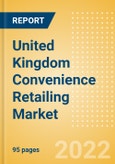United Kingdom (UK) Convenience Retailing Market Size, Trends, Consumer Attitudes and Key Players, 2021-2026 report offers comprehensive insight and analysis of the convenience retailing market, the major players, key trends, and consumer attitudes. It provides in-depth analysis of the hot issues impacting the market (such as inflation, ambient retail, rapid delivery and post-COVID consumer behavior), strategies for success, market sizes and forecasts to 2026, retailer profiles and market shares, and consumer shopping behavior. Consumer data is based on our 2021 UK How Britain Shops survey, using a panel of 10,000 nationally representative consumers.
The convenience retailing market will see marginal growth. Facing tough comparatives of the last two years and a cost-of-living crisis, we forecast spend at convenience stores to rise just 0.4% in 2022. Volumes will be down, especially in neighborhood locations, but inflation will help to offset this. The level of growth will gradually pick up from 2023 with the market reaching £42.7bn in 2026 - up 12.5% on 2021, equating to an extra £4.7bn. While some consumers will return to the office, hybrid working is a permanent shift which will benefit convenience players in the long term. Range development, loyalty schemes and localized sourcing will support footfall.
The convenience retailing market will see marginal growth. Facing tough comparatives of the last two years and a cost-of-living crisis, we forecast spend at convenience stores to rise just 0.4% in 2022. Volumes will be down, especially in neighborhood locations, but inflation will help to offset this. The level of growth will gradually pick up from 2023 with the market reaching £42.7bn in 2026 - up 12.5% on 2021, equating to an extra £4.7bn. While some consumers will return to the office, hybrid working is a permanent shift which will benefit convenience players in the long term. Range development, loyalty schemes and localized sourcing will support footfall.
Scope
- The UK convenience market witnessed an impressive boost in 2020 as consumers shopped closer to home and relied more heavily on their local stores - leading to range diversification, especially at the independents, which boosted average basket size and visit frequency.
- Players highly exposed to urban areas and forecourts, namely Tesco and Sainsbury's, saw footfall decline during COVID as consumers worked from home and stayed local. These players will see share pick up in 2022 as neighborhood convenience stores suffer a decline in footfall as consumers return to the office and shift spend to high street discounters.
- The pandemic has accelerated the shift to online, especially within food & grocery.
Reasons to Buy
- Using our five year forecasts to 2026, learn which areas of the convenience market will be the fastest performing to enable focus and investment in these winning product areas.
- Understand how drivers of convenience purchases, such as range, price and quality, vary in importance among different demographics in order to maximize sales potential.
- Use our in-depth analysis of the challenges faced by key retailers in the sector in order to understand how to steal shoppers and market share.
Table of Contents
- Executive Summary
- Key Trends in the UK Convenience Retailing Market
- Drivers and inhibitors
- Key trends
- Strategies for success
- UK Convenience Retailing Market 2021 2026
- Market size and forecasts
- Category performance and forecasts
- Channel performance and forecasts
- Competitive Landscape
- Revenue and market shares of Top 10 players
- Profiles of leading players
- Consumers
- Penetration & profile
- Channel usage & fulfilment methods
- Purchase frequency
- Consumer drivers
- Shopper preferences
- Methodology, Definitions & Contacts
Companies Mentioned (Partial List)
A selection of companies mentioned in this report includes, but is not limited to:
- Aldi
- B&M
- Home Bargains
- Iceland
- Lidl
- Poundshop.com
- Poundstretcher
- Poundland
- Tesco
- Sainsbury's
- ASDA
- Amazon
- Getir
- Gorillas
- Spar
- Co-op
- Marks & Spencer








